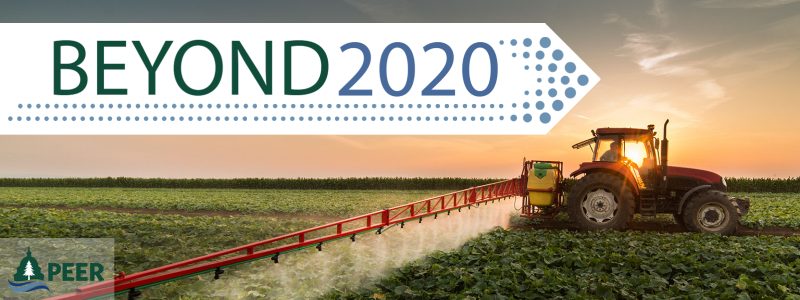Pesticides
A Vision for Pesticide Policies That Protect the Environment and Public Health
Preface
For more than a quarter century, Public Employees for Environmental Responsibility (PEER) has served environmental professionals concerned with regulation of pesticides. This paper lays out PEER’s recommendations that Congress, the U.S. Environmental Protection Agency (EPA), and other federal and state agencies should take in order to protect the environment and public health from pesticides. The current system is broken. Legislative and policy changes – and an overall shift from pesticide dependence towards healthy, organic and regenerative agriculture and land use practices – are needed now. These overdue improvements will benefit the environment, health, and the economy for current and future generations
Introduction
In many states, cities and towns can spray schools or town parks and athletic fields with toxic herbicides like 2,4-D, which was a component of the infamous defoliant Agent Orange and is linked with liver and nerve damage. In agricultural areas, large-scale spraying of the highly toxic organophosphate group of pesticides may take place adjacent to homes and day cares, while farmworkers can be exposed both at work and at home. And now evidence has come to light indicating that many pesticides may contain toxic per- and polyfluoroalkyl substances, or PFAS, known as “forever chemicals” because they do not break down under natural conditions.1
How is this possible?
The primary federal pesticide law, the Federal Insecticide, Fungicide and Rodenticide Act, or FIFRA, was passed in 1947. World War II had ended, factories were shifting to peacetime manufacturing, and the economy was taking off – with vastly expanded chemicals production as part of this growth. “Better living through chemistry” was the mantra of this modern way of life.
Over time, FIFRA has proven to be utterly inadequate. It is based on a flimsy system of registration and labeling. The EPA has continued to approve products that are inadequately tested or that raise serious environmental and health concerns. The law makes it very difficult to reverse course, so once approved, pesticides often continue to be used even if new evidence of harm comes to light.
As a result, our agricultural system – and even urban and suburban lawn care – are chemically focused. More than 500 active pesticide ingredients have been used in agricultural applications in the U.S. since 1970, according to Nathan Donley of the Center for Biological Diversity,2 and the U.S. uses over a billion pounds of pesticides annually.3
Various pesticides are linked with health problems including asthma, infertility, Parkinson’s disease, learning disabilities, and cancer. Pregnant women, children and Environmental Justice communities are especially vulnerable. Pesticides can pollute waterways and poison animals, including pollinators, fish, and birds.
With growing pesticide use, more traditional, sustainable practices have decreased. “Throughout the past half-century of insect pest management system change, farmers have become progressively more dependent on insecticide and toxin-based interventions, and incrementally more divorced from prevention-based, integrated systems that rely mostly on management of ecological interactions and biological control mechanisms,” says Charles Benbrook of Johns Hopkins University.4
We now stand at a crossroads: The start of a new administration in Washington, combined with the crises of environmental degradation and a pandemic that illuminates the importance of upstream government action to protect public health. The U.S. must rapidly move away from dependence on toxic pesticides; more strictly control the pesticides we use; and embrace organic and regenerative agriculture and land care practices.
The next sections describe the directions that PEER will be pressing the federal government to pursue. This includes overhauling FIFRA in order to address the law’s core weaknesses, protecting vulnerable populations, and taking an overall approach that advances pest management strategies that are not dependent on toxic inputs.
Shortcomings of the Current System
Many shortcomings of the current system are due directly to provisions of the federal law.
Registration of New Pesticides
“Unreasonable adverse effects” standard. Under FIFRA, new pesticides must be registered for use by EPA, and existing pesticides “re-registered,” based on a finding that they do not cause “unreasonable adverse effects on man or the environment.”5 FIFRA defines this as “any unreasonable risk to man or the environment, taking into account the economic, social, and environmental costs and benefits of the use of any pesticide.” Thus – unlike many other environmental laws – EPA must carry out a cost-benefit analysis that does not prioritize public health protection. In practice, this provision often leads EPA to assume economic and social benefits, even without evidence. Additionally, many “external” costs are not considered, such as the costs to families, the health care system, and the educational system when pesticides cause health problems or learning disabilities.
No requirement for alternatives assessment. Alternatives assessment is a process for comparing alternatives and identifying those that are safer.6 It is a growing focus of environmental health researchers and practitioners. FIFRA does not require or provide a way for EPA to include in its analysis whether alternative products or practices could achieve a proposed new or existing pesticide’s benefits with less harm to public health or the environment.
No requirement for analysis of complete products, including “inert” ingredients. Pesticide products often contain more than one active ingredient, as well as “inert” ingredients that may comprise the majority of the product and be harmful themselves. Yet under FIFRA, EPA reviews one active ingredient at a time rather than the full combination of ingredients that comprise a product, despite the fact that both the active ingredients and the inerts can cause “synergistic” toxic reactions when it comes to real life exposures. So, for example, EPA reviewed the herbicide glyphosate, but not the full complement of ingredients in Roundup, the popular product that contains glyphosate.7
No requirement to show essentiality or efficacy. Under FIFRA, EPA is not able to deny registration because a pesticide is not essential. In addition, EPA may waive data requirements pertaining to efficacy and register a pesticide without determining that it is efficacious.8 In fact, many approved pesticide uses have not been shown to be efficacious – that is, their economic benefit to the farmer does not, on average, exceed their costs to the farmer.
Labeling
Label information is inadequate. Per FIFRA, all information and instructions regarding a pesticide’s use, including warning language, are included on its label.9 But the label as a repository for the totality of this information is insufficient. Even when an applicator follows the label’s instructions, harm often occurs – for example, a sprayed pesticide drifts to residential properties. While EPA assumes in its risk analyses that a product will be used as directed on the label, this is often not the case, and warning language is often misunderstood or ignored by users.
Conditional approvals and emergency exemptions
FIFRA allows EPA to “conditionally” register a pesticide.10 Under this major loophole, an applicant can delay submitting data to EPA “because it has not yet been generated” and the EPA can register the pesticide without this information. EPA has grossly overused this special condition. FIFRA also allows so-called emergency exemptions that allow special uses of pesticides for which they are not registered.11 The agency has also over-authorized this exemption, which is a nationwide problem with almost no accountability because they last for short periods of time and are therefore almost impossible to litigate against.
Bans
FIFRA makes it extremely difficult for EPA to ban a pesticide.12 The law allows the pesticide manufacturer to challenge cancellations of registrations in highly burdensome hearings that the agency does not have the resources to conduct. The EPA is required to consider restricting the pesticide’s use instead of cancelling it and must consider a ban’s impact on the agricultural economy. As a result, the U.S. continues to use pesticides that have been banned by the European Union and other countries and regions.13
Additional Concerns
Additional concerns include insufficient protection for vulnerable groups like children and farmworkers, and EPA’s policy exemption of systemic insecticide-coated seeds from registration and enforceable label requirements. The label warnings on bags of neonicotinoid-coated seeds are advisory only; they are not enforceable. This includes almost all neonicotinoid-coated seeds, which are now the most widespread insecticide applications nationally, extending over more than 100 million acres per year. They are causing severe declines in pollinators, birds, aquatic systems and soil health.14
Agenda for Reform
1. Overhaul FIFRA
Replace the “unreasonable adverse effects” standard with a hazard-based standard. A new standard for registration is needed in order to realign EPA’s focus primarily on human and environmental health. The current system is based on assessing risk – the likelihood of exposure – rather than hazard, which is the inherent ability of a substance to cause harm. A standard that assesses hazards of a proposed pesticide would allow prioritization of public health protection.
Require review of fully formulated products. EPA must be required to review effects of the pesticide products themselves, which often contain multiple active and inert ingredients – rather than one ingredient at a time. This will enable assessment of synergistic effects of pesticide exposure.
Efficacy and essentiality. EPA should be required to consider efficacy and essentiality of pesticides, and to prioritize alternatives if health or environmental hazard thresholds are met, uncertainties exist, or essentiality cannot be confirmed. For example, an applicant should be required to submit a detailed showing of efficacy: that a pesticide’s benefits to farmers will significantly exceed the overall costs to farmers.
Require alternatives assessment. A registrant should be required to demonstrate that there are no alternative products or practices that carry less risk to human health and the environment, but can achieve the same purpose, as the proposed new pesticide or pesticide undergoing reregistration review. Thus, the EPA will first ask: Is there a healthier way to achieve the proposed product’s purpose? Is there another product or practice that would make this pesticide unnecessary? This approach innately considers essentiality. It creates a vastly broader perspective, one in which policymakers think about pesticide use as part of a system, rather than narrowly focusing on one pesticide at a time. Without this capacious view, we risk simply replacing one health-harming pesticide with another, known as regrettable substitution. As Benbrook notes, “Whack-a-mole is an inefficient and usually futile regulatory approach.”15
Cancer and reproductive risk. Consider following the example of the European Union, which prohibits the approval and use of pesticides that are mutagens, carcinogens, reproductive toxicants or endocrine disruptors unless exposure is negligible, as described by Donley.16California also provides an example to build on with its Proposition 65 law, which requires written warnings about chemicals that cause cancer, birth defects or other reproductive harm in products, homes, workplaces, or that are released into the environment. It prohibits businesses “from knowingly discharging significant amounts of listed chemicals into sources of drinking water.”17
Close loopholes on conditional registrations and so-called emergency exemptions. The conditional registration18 loophole in FIFRA should be closed. This allows EPA to register a pesticide even though the applicant has not submitted important health and safety data to EPA. The emergency exemptions loophole should also be closed. This allows special uses of pesticides for which they are not registered.19 The agency has over-used these two exemptions and the law has created a system where agency decisions are virtually impossible to challenge.
Make it easier to ban harmful pesticides and make it mandatory for EPA to rapidly remove banned pesticides from use, including existing stocks. It should not be so difficult under FIFRA for EPA to ban a pesticide.20 As a result, the U.S. continues to use dangerous pesticides that have been banned by the European Union and other countries and regions.21
Require more frequent review of registered pesticides. FIFRA requires reviews of registered pesticides every 15 years.22 This is inadequate given potential health and environmental impacts, and these reviews have not taken place on schedule in any case. Review every five years should be required. In addition, there should be required monitoring of new pesticides following several years of use. Benbrook suggests collecting environmental, human exposure, and biomonitoring data, and potentially revisiting risk assessments.23
2. Additional Policy Actions
Improve guidelines on data. The review process for registration and re-registration relies largely on data that are provided by the applicant and not peer reviewed. The EPA should develop more stringent guidelines for such data, including a requirement that toxicity studies be commissioned by regulatory authorities, not by the chemical industry. As an example of the importance of this issue, Benbrook analyzed why the International Agency for Research on Cancer (IARC) and the EPA came to such different conclusions about the herbicide glyphosate; EPA considers glyphosate “not likely to be carcinogenic to humans” while IARC has classified glyphosate as “probably carcinogenic to humans.”24 He identified several reasons, including that in the core tables compiled by the two agencies, “the EPA relied mostly on registrant-commissioned, unpublished regulatory studies, 99% of which were negative, while IARC relied mostly on peer-reviewed studies of which 70% were positive.”
Take action on inert ingredients. Inert ingredients often constitute the vast majority of a pesticide product, and they can be as toxic as the active ingredient. Regulators should ban or restrict inert ingredients that could cause significant harm. Additionally, inerts should be identified on pesticide labels.
Require registration of systemic insecticide-coated seeds as pesticides and include enforceable labels for their use.
End state pre-emption. Many state governments, following lobbying by the pesticide industry, have passed laws pre-empting the right of local governments to regulate pesticides.25 A growing number of municipalities, recognizing that federal and state regulation provide inadequate protection, are pushing back on these strictures. Reform is needed at the federal level to assert the right of localities to enact pesticide policies that are stricter than those of EPA and states.
Protect vulnerable populations. No-spray zones and buffer zones should be established to protect children at schools and day care centers. FIFRA reform should protect farmworkers, who often have high levels of pesticide exposure. This should include outreach to physicians so that they can better recognize and report pesticide-linked illness and assurance of the ability of state officials to inspect the sites of such incidents without prior notice to the employer.
Implement the Endangered Species Act (ESA) for pesticides. Pesticides, especially when they enter waterways, can harm endangered species including fish, birds, amphibians, marine mammals, and sea turtles. The ESA requires EPA to consult with other federal agencies to ensure that its actions do not threaten these species. However, EPA has been slow to establish a process for effectively and efficiently ensuring that pesticides do not continue to threaten these animals.
Establish an expert Advisory Committee. This committee would improve label language, ensuring that each label is clear and understandable. It should commission independent evaluations of label compliance.
3. Promote Organic and Regenerative Agriculture and Land Care
The EPA and other agencies should support overall pesticide reduction strategies – especially organic and regenerative agriculture and land use practices. Organic practices do not involve any toxic pesticide use. Organic land care in the urban and suburban environment focuses on “cultural controls” like aerating, mowing high, and application of organic products that improve soil health and the turf’s ability to fend off weeds naturally. Unfortunately, currently multiple pesticides with serious human health and environmental impacts are approved by EPA and used for cosmetic lawn and turf care. Organic agricultural practices, regulated under the federal Organic Food Production Act (OFPA), also focus on improving soil health, and include crop rotation, application of compost, and biological pest control techniques like natural predators. The U.S. Department of Agriculture implements OFPA, and states like California help implement and enforce the law and oversee organic certification programs. Raw and processed agricultural products certified as organic may bear the USDA organic label.
Regenerative agriculture aims to reduce the large carbon dioxide outputs of the agriculture sector. It focuses on rehabilitating the agricultural ecosystem through a holistic perspective and practices that include conservation tillage, plant diversification, rotation of crops, cover crops, and caution about inputs like soil amendments.26 Unlike organic agriculture, regenerative agriculture does not have a defined or enforceable meaning, but its philosophy and practices can supplement OFPA’s requirements for the organic label.
Integrated Pest Management, or IPM, is often advanced as a means to reduce pesticide use and enhance environmental protection. However, it generally has not been successful in reducing pesticide use. IPM allows some pesticide use – in principle, only the least toxic, used only as a last resort. In practice, whether due to confusion about IPM or discomfort about moving away from pesticide-focused practices, IPM often involves pesticide use as a first resort and with use of more rather than less toxic products.
In addition to the legislative and policy reforms described in the sections above, the EPA and other agencies should support and promote organic land care. They should work with state health, environment and agriculture departments to provide information, education and technical assistance on techniques to reduce reliance on pesticides. They should also support education for consumers about the benefits of organic products.
4. Use Less Toxic Methods to Address Mosquito-Borne Illnesses
As climate change increases temperatures and alters precipitation patterns, the United States will see new mosquito-borne viruses, and expansion of the geographic distribution of existing mosquito-borne diseases. The knee-jerk “better living through chemistry” reaction of state and municipal governments will likely result in even more spraying of toxic pesticides to combat these new threats. However, the alarming insect apocalypse demands that we find alternative, less toxic methods of preventing mosquito-borne illnesses. One possibility is restoration of natural areas, as intact ecological landscapes can be effective means of controlling mosquito populations. Both the city of Boulder, Colorado and Washington DC have abandoned application of traditional adulticides in favor of education, testing, larviciding, and ecological approaches to mosquito control, proving that it is possible to end our addiction to harmful poisons in our efforts to combat arboviruses. Our discovery of per-and polyfluoroalkyl substances (PFAS) in Anvil 10+10, a commonly used insecticide for mosquito control, makes it imperative that we find alternatives to traditional pesticide application.
Conclusion
To protect the environment and public health, law and policy must ensure that harmful pesticides are not approved for use, and that previously approved dangerous pesticides are banned. Overall, the U.S. must move away as rapidly as possible from our dependency on pesticides and embrace more organic and regenerative modes of agriculture and land care. Congress should enact FIFRA reform, and the EPA and other federal agencies should lead the shift to safer and healthier pest control practices and products. PEER and its allies will continue to advocate for these overdue and badly needed changes.
References within this document are available in the print version, available for download here.
 Paula Dinerstein is PEER’s General Counsel and represents PEER in whistleblower, environmental and FOIA cases.
Paula Dinerstein is PEER’s General Counsel and represents PEER in whistleblower, environmental and FOIA cases.
 Peter Jenkins is PEER’s Senior Counsel.
Peter Jenkins is PEER’s Senior Counsel.
 Susan Kaplan is a Guest Contributor. She is an environmental lawyer, professor and writer.
Susan Kaplan is a Guest Contributor. She is an environmental lawyer, professor and writer.
